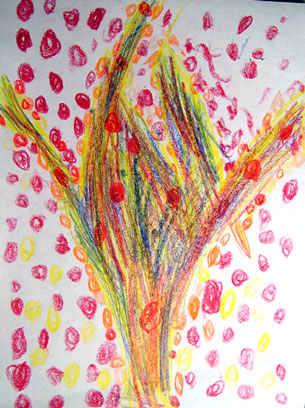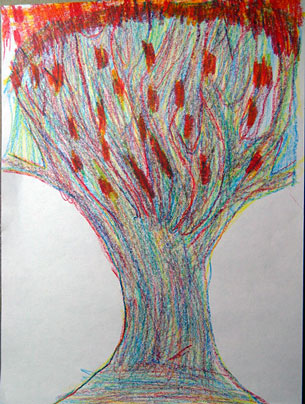Second Grade Art Lesson 4
Coloring Fall Trees, Part 1 Warm and Primary Colors
Objective:
The students will learn that primary colors are red, yellow and blue and will use these colors together to discover how they mix. The student will look at fall trees to notice the warm colors, red, yellow and orange, and mix these colors together to complete their tree drawing.
Materials:
White drawing paper (9 x 12), crayons, pictures of or actual fall trees (changing leaves)
Procedure:
Begin by asking the children if they have noticed any outdoor changes lately. Guide them to notice the changing of the colors of the leaves on the fall trees. (If climate change has not occurred and will not occur, discuss weather changes and use pictures to help the children see leaves in fall splendor.) Explain that we are going to use trees as a subject to study color. Review what we learned while making our color wheel. The primary colors are red, yellow and blue. These are the three colors we began with on our color wheel and are the most important colors because we cannot use other colors to mix these three. Moreover, with these three colors we can create many other colors. Mixing all three together makes a neutral color like brown. We are going to draw a fall tree and use the primary colors on the trunk and limbs of the tree. We will use the warm colors, red, yellow and orange, to fill the branches with the fall leaves. Distribute paper and crayons. Demonstrate basic tree shapes (see video demonstration if you are unsure) and have them look closely at actual trees or pictures. Be sure to point out how the tree branches do not end with straight edges, but rather in a point. Encourage the students to draw large filling their page with the tree. Begin drawing with the yellow crayon to get the outline. Trace over the outline with red, then blue. Once the main shape is drawn off, color the inside of the tree first with yellow, then layer with red, then blue. Suggest they play with the colors to get a variation of browns and emphasize that while this does not look like the brown crayon they are used to coloring with, it gives a richer look to the tree trunk typically colored with a dull brown crayon. Next have them collect the warm colors and begin coloring in the tree leaves. This can be done using a controlled scribble technique, where each leaf is not actually drawn off but a leafy texture is created. (Again, view the demonstration.) Have the students put their names on the back of their work and store them in a safe place for next weeks lesson.
Conclusion:
Review the color information we learned today: Primary colors mixed to make a neutral color, and the warm colors. Have the children lay their drawings out for everyone to see and make positive comments about their use of color, the tree form or the fullness of the leaves. Be sure to find something positive to say about each individual work.
Artwork and Examples used in this lesson

Student Artwork

Student Artwork













